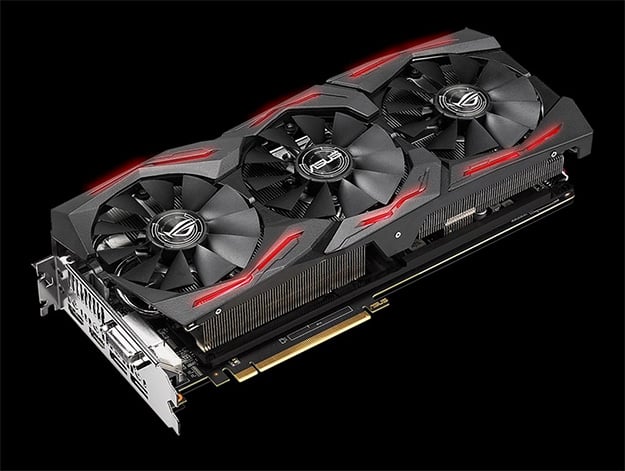ASUS Announces Two New ROG Strix RX Vega 56 8GB Graphics Cards
There are not a whole of Radeon RX Vega graphics cards to choose from at the moment (pretty typical following a launch), but that is going to change. So too will the lack of custom cooled Vega cards by AMD's hardware partners. ASUS alone is prepping a handful of Vega cards, including several under its Republic of Gamers (ROG) banner (and a rumored dual-GPU model). After having strutted out a bunch of Radeon RX Vega 64 cards at the end of July, ASUS has put up products pages for two Radeon RX Vega 56 parts.
These are both ROG cards. The include the ROG Strix RV Vega 56 (ROG-STRIX-RXVEGA56-8G-GAMING) with 8GB of HBM2 memory on a 2,048-bit bus. ASUS does not list clockspeeds for this particular SKU, so we can only assume it is sticking to AMD's reference specs, which calls for a base clock of 1,156MHz and a boost clock of 1,471MHz.

As part of the ROG Strix family, this card is custom cooled with an aggressive looking shroud and three patented wing-blade fans that AMD claims collectively deliver 105 percent great static pressure over the heatsink, while operating up to 3X quieter than reference cards.
Underneath the hood are two finned aluminum blocks connected by heatpipes. These run to and from an enhanced copper heatspreader that makes direct contact with the GPU. ASUS says it uses precision machine to shave and form a surface that makes up to 2X more contact with the GPU than traditional heatspreaders, which in turn means more heat is transferred from the GPU and whisked away.

The other variant ASUS announced is the ROG Strix Vega 56 OC (ROG-STRIX-RXVEGA56-O8G-GAMING). Obviously this is an overclocked version of the non-OC edition, though unfortunately ASUS does mention clockspeeds for this one, either.
Outside from the presumed overclock, this version looks the same as the non-OC model and uses the same cooling solution. Both cards also feature the company's Aura Sync RGB lighting scheme, which lets users customize lighting colors and effects. The lighting can also be set to follow the pulse of music or change color based on the GPU load.
There is not word yet on how much these cards will cost or when they will be available.
These are both ROG cards. The include the ROG Strix RV Vega 56 (ROG-STRIX-RXVEGA56-8G-GAMING) with 8GB of HBM2 memory on a 2,048-bit bus. ASUS does not list clockspeeds for this particular SKU, so we can only assume it is sticking to AMD's reference specs, which calls for a base clock of 1,156MHz and a boost clock of 1,471MHz.

As part of the ROG Strix family, this card is custom cooled with an aggressive looking shroud and three patented wing-blade fans that AMD claims collectively deliver 105 percent great static pressure over the heatsink, while operating up to 3X quieter than reference cards.
Underneath the hood are two finned aluminum blocks connected by heatpipes. These run to and from an enhanced copper heatspreader that makes direct contact with the GPU. ASUS says it uses precision machine to shave and form a surface that makes up to 2X more contact with the GPU than traditional heatspreaders, which in turn means more heat is transferred from the GPU and whisked away.

The other variant ASUS announced is the ROG Strix Vega 56 OC (ROG-STRIX-RXVEGA56-O8G-GAMING). Obviously this is an overclocked version of the non-OC edition, though unfortunately ASUS does mention clockspeeds for this one, either.
Outside from the presumed overclock, this version looks the same as the non-OC model and uses the same cooling solution. Both cards also feature the company's Aura Sync RGB lighting scheme, which lets users customize lighting colors and effects. The lighting can also be set to follow the pulse of music or change color based on the GPU load.
There is not word yet on how much these cards will cost or when they will be available.

